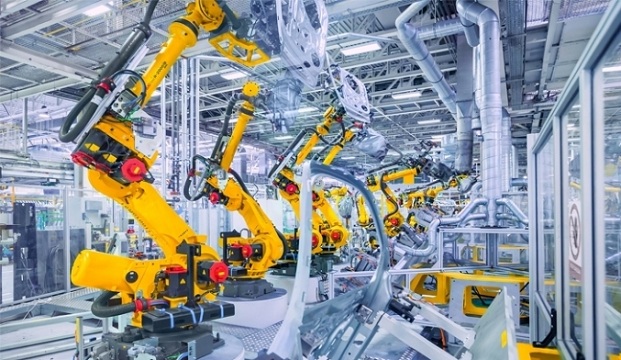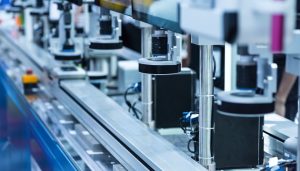Before, the mantra for businessmen was location, location, location. Today, it is automation, automation, automation. Robots, computers and other new technologies are automating a growing range of job functions. This increases productivity and creates economic growth – but what about all the workers that are made obsolete?
Recent studies from the United States show that productivity in the nation’s factories has doubled in just 13 years from 1997 to 2010. This means that each factory worker now produces twice as much value per work hour than a baker’s dozen of years ago. The number reflects a growth in produced goods of one-third, measured by price in present-day dollars, but also a reduction in the number of industry workers by one-third. This is a notable drop, particularly as employment in the US industry was roughly constant the previous 30 years (though with a relative decline due to a growth of the overall workforce during this time). This notable drop in employment is concurrent with a growth in production has made many economists speak of ‘jobless growth’, i.e. that the economy improves without improving employment.
We have had growth in productivity at least since the dawn of the industrial age, but some things suggest that it’s going faster now. As mentioned above, the latest doubling of productivity took 13 years, but the previous doubling took 21 years (1976-1997), and the one before that took 26 years (1950-1976). Hence, we are speaking of a faster than exponential growth (where doublings happen at regular intervals). When we add to this that most manufactured goods become cheaper over time, the real productivity growth, measured by the volume of goods rather than their sales price, is even larger.
It’s not just the production of physical products that becomes automated. The service industries also experience increasing automation, e.g. in banking, where internet banks have led to many local banks closing and a reduction of service staff in those that remaining. Robots are also gaining ground in the health and cleaning sectors; fields that up to now haven’t experienced the same degree of automation as have other industries. In Japan, humanoid fast-food robots have made quite a stir, and although they so far mainly are meant as gimmicks, there’s little doubt that the fast-food industry is facing massive automation as well. As an example, the San Francisco-based company Momentum Machines has developed a robot, called Alpha, which can produce 360 burgers in an hour – or one every 10 seconds. The quality is very good, too: the meat isn’t ground until the burger has been ordered, and the vegetables aren’t chopped until the meat has been grilled. Finally, the machine wraps the burger, serving it untouched by human hand. Future versions of Alpha will be able to make tailored burgers where you e.g. can order a burger made from half veal, half lamb.
Better computers, better robots
Moore’s Law predicts a doubling of computer processing power compared to price every 18 months. This means 100 times as much power in 10 years, and 10,000 times as much in 20 years. In fact, processor speed in chips hasn’t increased much over the last decade (see the article on the preceding page) because we are approaching the limit of what we can achieve with silicon-based chips. However, this doesn’t mean that progress grinds to a halt. Several replacement technologies for silicon chips are underway, like chips made from carbon nanotubes, which IBM among others is developing, not to mention the much-hyped quantum computers that use quantum-mechanical effects to perform many calculations at once. At any rate, it’s not unrealistic to count on that by 2030, we will get 1000-2000 times as much processing power for the buck as we get now. If computer programming can keep pace with capacity, it means that by then we will have cheap computers able to handle just as complex problems as humans can. We see this even now with robot cars that drive just as safely as people. This is still experimental, and the robot cars probably aren’t exactly cheap, but 10 years from now, fully autonomous robot cars will likely not be uncommon on the streets.
We also see rapid advances in robots, meaning computers equipped to be able to sense and influence their physical surroundings. It is difficult to evaluate what the growth in robot capacity will be since it is a combination of better computers, better sensors and actuators (tools for handling physical objects), and better programming – and in addition, the price depends highly on the number of robots produced. About ten years ago, the UN found that the cost of robot labour, measured by both greater speed, increased flexibility and lower cost, dropped to one-fifth in ten years, corresponding to an expected drop in price of 93-94 per cent from today to 2030. Since then, things may have happened even faster, and at the same time the robots have become able to handle increasingly complex tasks. In a few years, we will be able to buy generic robots that can be programmed for specific tasks by installing various programs or ‘apps’. A forerunner of this is ‘Baxter’ from Rethink Robotics, a twin-armed robot costing $22,000 (roughly €17,000), which easily can be programmed to handle simple tasks. If Baxter can replace just one part-time employee, it will pay for itself in a year.
Even low-paid Chinese factory workers are being replaced by robots. In June of 2011, Foxconn, the Chinese factory that among other things produces Apple’s iPhone, announced that it would replace one million workers with just as many robots. This process is already underway. Recently, an employee at Foxconn told Wall Street Journal that an assembly line that used to be manned by 20-30 workers now is handled by robots and five service workers.
What’s left for us to do?
If a robot is competitive with a low-paid Chinese industry worker, it is even more competitive compared with expensive Western labour. And tomorrow’s robots and computers will become even cheaper, faster and easier to program. The production of physical products can also be done cheaper and more flexibly by using 3D printers, a technology that still is in its infancy, but is considered the path to a new industrial revolution – by implication, one that doesn’t require nearly as much labour as today.
The result will be a pervasive automation of almost all the industries we have today, including many of the knowledge-intensive service jobs that make up the major part of the labour market in developed nations. Unskilled labour in particular will face automation, but also highly skilled labour in teaching, the financial sector, health, transportation, and much else will be automated over the next decade or two.
This will most likely mean that an increasing number of people will find it difficult to get work in their own profession, as we have already seen it in the US with the above-mentioned decline in industry employment by a third in just 13 years. In addition, many of the jobs that you could previously depend on falling back on are becoming automated. There’s no need of cab drivers when the cars can drive themselves; there’s no need of burger flippers when the fast-food joints are fully automated, and the need for people in retail will decline as be buy more and more online.
In the past, increased productivity through automation and the derived economic growth have given birth to new needs and hence new markets with new jobs. This will likely also happen this time around – but the question is whether new jobs in new industries will be created at the same pace as jobs in existing industries become automated. In addition, will it be possible to retrain all the obsolete workers for jobs in the new industries when the skill level increases for jobs that aren’t easily automated?
If we were to point at job types that aren’t immediately in danger of being automated, there are basically only two fields that won’t be affected. One is the creative industry in the broad sense, i.e. research and development, culture and entertainment, and design and fashion. The other field is service jobs with a particularly high level of competency, like doctors, personal coaches, and business leaders, or where customers are willing to pay extra for real human service, like in the night life (DJs, waiters, bartenders, and sex workers). Even within many of these job types, automation will gain ground in the shape of tools that ease planning, administration and other routine tasks, enabling fewer employees to handle the same workload.
Can we imagine that all the people that today are employed in production industry and the less educated parts of the service industry and the financial sector can be retrained for jobs in these fields? And that there will be a need for so many more in these fields that they can absorb everybody who will be made obsolete by automation? Personally, I find this difficult to imagine, but I may be wrong.
If we don’t manage to create new jobs at the same rate as the old ones disappear – and this doesn’t seem likely – there are in reality two possible scenarios: Either we will get increasing unemployment with a growing part of the population unable to find employment, or we become better at sharing the jobs that are left. The last doesn’t seem particularly likely, simply because the level of competence for most of the remaining jobs will be so high that not everyone will be able to handle them – although a reduction of the annual work time through longer holidays and shorter work weeks could be a part of the solution. Hence, the most likely scenario is that we will get far more unemployed than we have today, and the question then becomes how we will treat these unfortunate people. Will we cut benefits and force the unemployed into futile activation with meaningless tasks? Or will we accept that there aren’t jobs for everybody and at least make sure that the unemployable can lead dignified lives?
In 1970, the famous American inventor and thinker Buckminster Fuller said that: “We must do away with the absolutely specious notion that everybody has to earn a living. It is a fact today that one in ten thousand of us can make a technological breakthrough capable of supporting all the rest. We keep inventing jobs because of this false idea that everybody has to be employed at some kind of drudgery because, according to Malthusian-Darwinian theory, he must justify his right to exist.”
This isn’t a thought that very many politicians are willing or courageous enough to think, but the time may have arrived when they need to think it. If not, the result may be that a growing part of the population becomes employed in trying to find non-existing employment for a growing part of the population – an absurd trend that actually has been going on for some time. This is not likely to be beneficial for productivity in the long run.









